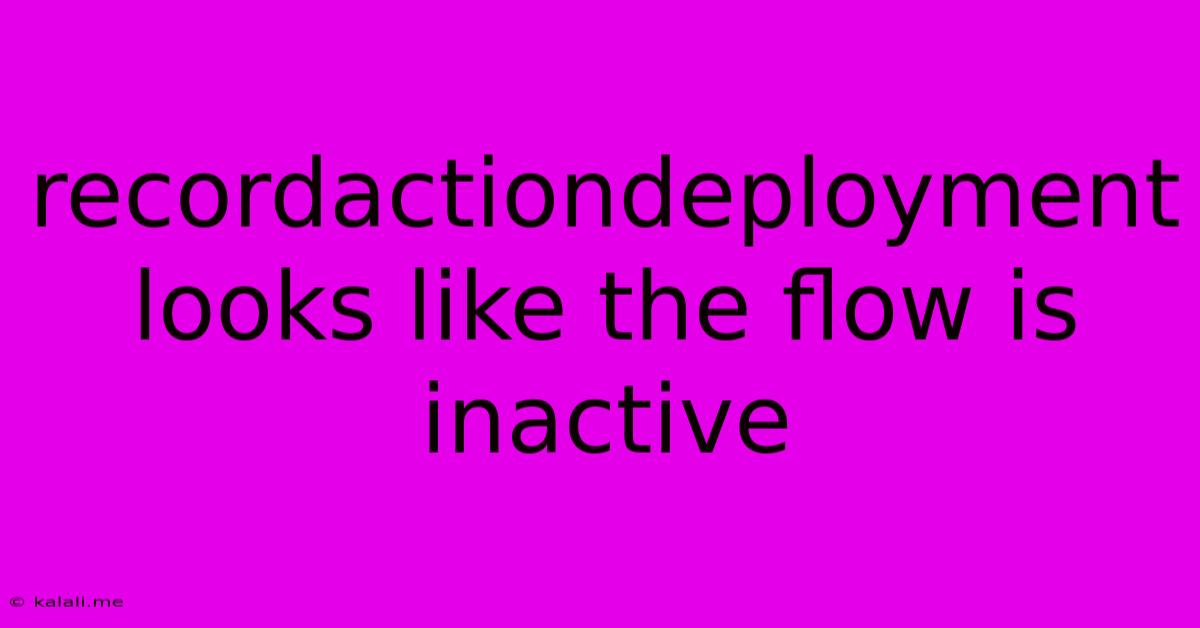Recordactiondeployment Looks Like The Flow Is Inactive
Kalali
May 26, 2025 · 3 min read

Table of Contents
RecordActionDeployment: Troubleshooting "Flow is Inactive" Errors
This article addresses a common problem encountered when deploying Record-Triggered Flows in Salesforce: the "Flow is Inactive" error message within the RecordActionDeployment component. This error prevents your flow from automatically executing when a record meets specific criteria, hindering your automation efforts. We'll explore the common causes and provide solutions to get your flow up and running. This guide focuses on practical troubleshooting steps for Salesforce developers and administrators.
Understanding RecordActionDeployment and the "Inactive Flow" Issue
RecordActionDeployment is a crucial component in Salesforce's declarative development framework. It allows you to seamlessly integrate automated processes, triggered by record changes (e.g., creation, update, deletion), without writing complex Apex code. When you encounter the "Flow is Inactive" error, it means the flow associated with your RecordActionDeployment isn't active, preventing the automated actions from taking place. This can manifest as unexpected behavior, particularly when you expect your flow to execute after a record is created or updated.
Common Causes and Troubleshooting Steps
Several factors can contribute to the "Flow is Inactive" error during RecordActionDeployment:
1. Flow Status:
- Problem: The most straightforward cause is the flow itself being inactive. This might be due to a deployment issue, manual deactivation, or an error during flow development.
- Solution: Navigate to your Flow's setup page. Verify its status. If it's inactive, activate it. Check the flow's debug log for any errors that might have occurred during its previous runs.
2. Incorrect Flow Version:
- Problem: Your RecordActionDeployment might be referencing an older, inactive version of your flow. Salesforce allows for multiple versions of flows.
- Solution: In the RecordActionDeployment setup, double-check that you are pointing to the correct, active version of your flow. Ensure the version you selected is the latest, active version.
3. API Permission Issues:
- Problem: The user or profile running the RecordActionDeployment might lack the necessary API permissions to activate or execute the flow.
- Solution: Review the user or profile's permissions, ensuring they have the appropriate API access, such as "Activate Flows" and execute the related actions. You might need to adjust the permission set assigned to the user or profile.
4. Deployment Errors:
- Problem: During deployment, particularly in managed packages, issues could prevent the flow from activating correctly.
- Solution: Review your deployment logs carefully for any errors related to the flow deployment. Address these errors, making sure the flow deploys without any issues. Consider using a more robust deployment tool for larger org deployments.
5. Metadata API Conflicts:
- Problem: Conflicts during metadata API deployments can sometimes leave the flow in an inconsistent state.
- Solution: If you're using the Metadata API, ensure your deployments are properly handled to avoid conflicts. Consider using tools that handle dependency management and conflict resolution to prevent this.
6. Sandbox Issues (for Sandbox Deployments):
- Problem: Flows behave differently across sandboxes and production orgs. Certain settings, especially those related to security or integrations, might vary.
- Solution: Thoroughly test your flow and RecordActionDeployment in all your environments (sandbox, UAT, production). Pay close attention to configurations that might differ.
7. Flow Definition Errors:
- Problem: Errors within the flow definition itself can prevent activation.
- Solution: Review the flow's definition thoroughly for any syntax errors, incorrect formula logic, or improper configuration of elements. Utilize Salesforce's flow debugging tools to pinpoint the exact location of any error.
Preventing Future Issues:
- Regular Testing: Implement a thorough testing strategy for your flows and RecordActionDeployments.
- Version Control: Utilize a version control system to manage your flows and their associated metadata.
- Detailed Logging: Leverage Salesforce's logging capabilities to monitor flow execution and identify issues proactively.
- Documentation: Maintain clear documentation describing your flow's functionality, configurations, and dependencies.
By carefully examining these potential causes and following the troubleshooting steps, you can effectively resolve the "Flow is Inactive" error within your RecordActionDeployment, ensuring smooth execution of your automated processes. Remember to test your flow thoroughly after implementing any changes.
Latest Posts
Latest Posts
-
Why Do British Singers Sound American
May 27, 2025
-
Where Was Jesus When Lazarus Died
May 27, 2025
-
Was Peter In The Bible Married
May 27, 2025
-
Is Momentum Conserved If A Spring Is In The Collision
May 27, 2025
-
How To Shingle A Lean To Shed Roof
May 27, 2025
Related Post
Thank you for visiting our website which covers about Recordactiondeployment Looks Like The Flow Is Inactive . We hope the information provided has been useful to you. Feel free to contact us if you have any questions or need further assistance. See you next time and don't miss to bookmark.